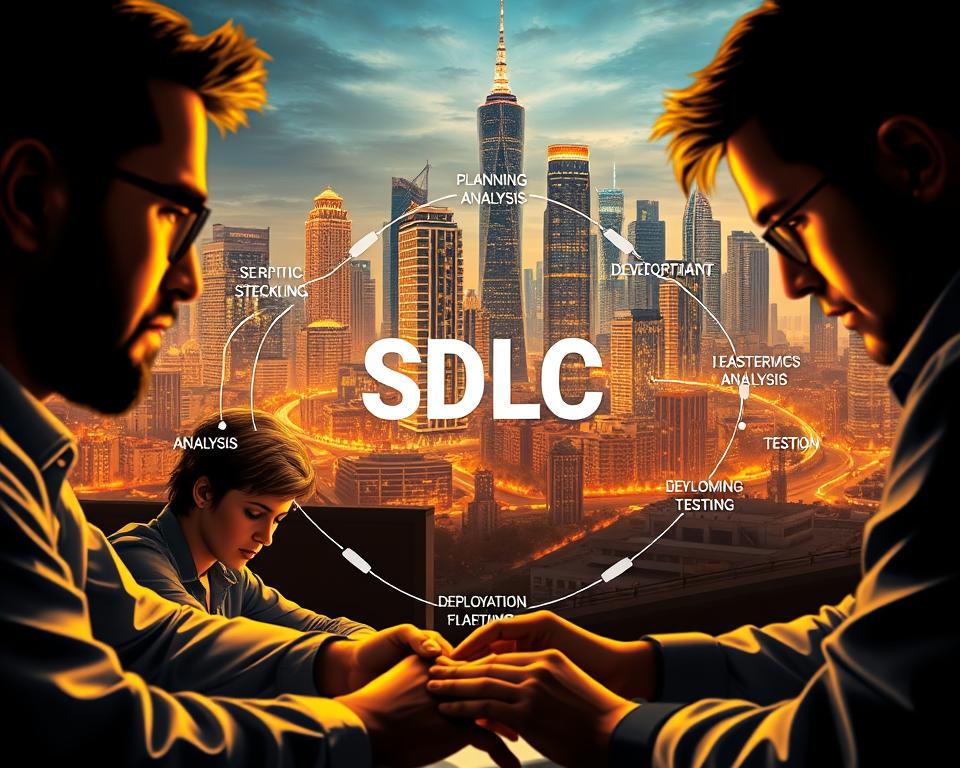
Explore the U.S. Department of Science and Technology
Did you know that federal investment in research and development from the u.s. department of science and technologyhas contributed to over 30% of the innovations in the technology sector? This remarkable statistic underscores the vital role that this government research agency plays in fostering scientific innovation across the country. As we delve deeper, we will explore how the u.s. department of science and technology leads the charge in advancing research, enhancing technological capabilities, and shaping the future of science in America.

Key Takeaways
- The u.s. department of science and technology is pivotal in driving technological advancements.
- Federal investments greatly influence innovation across various sectors.
- The department collaborates with numerous organizations to enhance research efforts.
- Scientific innovation is a key priority for the government agency.
- The u.s. department of science and technology shapes policies that impact technology development.
Introduction to the u.s. department of science and technology
The u.s. department of science and technology plays a critical role in advancing scientific progress across various fields. In this introduction, we explore the department’s foundational purpose and its commitment to fostering innovation. Established with the goal of enhancing national scientific endeavors, the department focuses on developing policies that support research and technology initiatives.
Its initiatives aim to strengthen partnerships among academic, governmental, and private sector organizations. These collaborative efforts not only encourage technological advancements but also ensure that the United States remains a leader in global scientific research. Understanding the U.S. Department of Science and Technology’s purpose helps to appreciate its impact on both national and international stages.
Mission and Vision of the Department
The mission of the U.S. Department of Science and Technology focuses on enhancing the nation’s potential for innovation and scientific excellence. This commitment is driven by a vision that sees technology as an essential component for solving complex challenges facing society. By prioritizing research and development, the department seeks to ensure technological advancements contribute positively to the economy as well as the well-being of the public.
Through fostering a collaborative environment, the department aims to bring together various stakeholders, including governmental agencies, private sector partners, and academic institutions. This approach cultivates an atmosphere where interdisciplinary efforts flourish, enabling groundbreaking discoveries and advancements. The overarching mission not only promotes scientific inquiry but also assures that the benefits of technology reach all sectors of society.

Key Functions of the u.s. department of science and technology
The u.s. department of science and technology plays a crucial role in the advancement of scientific endeavors and technological innovation. Among its key functions are the facilitation of research projects that drive forward health, safety, and economic growth. By funding targeted research initiatives, the department promotes advancements in various sectors, including healthcare and national defense.
Another significant function involves establishing comprehensive research agendas that align with national interests. These agendas guide scientists and researchers in addressing pressing challenges and harnessing new opportunities. The department focuses on integrating diverse scientific disciplines while prioritizing collaborative efforts between government bodies, academic institutions, and industry stakeholders.
Policy development represents a vital aspect of the department’s work. Through thoughtful policies, the u.s. department of science and technology influences how research and technology progress across multiple fields. This ensures that innovations not only enhance public health but also contribute positively to national security and economic competitiveness.
| Key Function | Description |
|---|---|
| Funding Research Projects | Allocates financial resources to support groundbreaking research across various fields. |
| Establishing Research Agendas | Defines priorities and objectives for research initiatives based on national needs. |
| Policy Development | Creates policies that shape the direction of scientific endeavors and technological advancements. |
| Research Facilitation | Encourages collaboration among institutions to address complex scientific problems. |
U.S. Department of Science and Technology and Government Research Agency
The U.S. Department of Science and Technology plays a pivotal role in fostering robust department interactions with various government research agencies. These collaborations are essential to align research funding with national initiatives. By pooling resources and expertise, both parties work towards advancing scientific endeavors that resonate with strategic priorities.
Cooperation often leads to more effective allocation of research funding, ensuring that projects reflect pressing societal needs. Joint efforts enhance the development of innovative solutions across sectors, reinforcing the importance of strategic partnerships within the scientific community. These interactions not only streamline processes but also help in identifying gaps in research that can be filled with targeted efforts.
The synergy created through department interactions does not merely address funding distributions; it also cultivates an environment ripe for groundbreaking discoveries. Agencies engaged in collaborative projects often witness enhanced capabilities in addressing complex challenges, ranging from environmental issues to technological advancements.
Scientific Innovation Initiatives
The U.S. Department of Science and Technology actively pursues initiatives designed to enhance scientific innovation across various sectors. These efforts aim to develop pioneering technologies that meet contemporary challenges while fostering robust research collaboration between academic institutions, private sector entities, and government agencies.
Pioneering New Technologies
The unveiling of new technologies forms the backbone of the department’s scientific innovation strategy. Investments in research projects focus on a diverse range of areas such as renewable energy, healthcare solutions, and information technology. The department emphasizes creating pioneering technologies that not only advance scientific knowledge but also serve the public good. Collaboration with leading universities and industry experts accelerates the transformation of theoretical advancements into practical applications.
Collaborative Research Efforts
Research collaboration stands as a fundamental principle in driving scientific innovation forward. The department encourages partnerships across various domains to maximize impact and efficiency. By bringing together diverse teams of scientists, engineers, and policymakers, the department enhances its capability to tackle complex issues. Such research collaboration enables the sharing of resources, expertise, and insights, leading to more effective solutions that benefit society as a whole.
| Technology Area | Description | Collaborating Partners |
|---|---|---|
| Renewable Energy | Development of sustainable energy solutions | National Labs, Universities |
| Healthcare Solutions | Innovative medical technologies and treatments | Medical Institutions, Startups |
| Information Technology | Advancements in computing and data analytics | Tech Companies, Research Institutes |
Federal Technological Advancements
The U.S. Department of Science and Technology plays a crucial role in fostering federal technological advancements that benefit the nation. Through various initiatives, the department ensures that government support is directed towards innovative projects with significant potential for improving public welfare and economic growth.
Federal technological advancements have led to breakthroughs in areas such as healthcare, renewable energy, and artificial intelligence. The innovation impact of these advancements has not gone unnoticed, as they contribute to maintaining the country’s competitive edge on a global scale.
Investment from government support facilitates collaboration among academic institutions, private sectors, and research organizations. This collaborative approach strengthens the development of new technologies and enhances their practical applications in everyday life.
- Enhancements in healthcare technology, improving patient outcomes.
- Advancements in clean energy solutions, promoting sustainability.
- Innovative artificial intelligence systems, transforming various industries.
Ultimately, the strategic focus on federal technological advancements through robust government support establishes a foundation for continued innovation, benefiting both current and future generations.
National Science Initiatives Promoted by the Department
The U.S. Department of Science and Technology actively promotes national science initiatives designed to advance research and development across various disciplines. These initiatives focus on solving intricate problems by leveraging interdisciplinary approaches and fostering relationships through global scientific partnerships. Collaborative efforts enable researchers to bring together diverse skill sets and insights, enhancing the impact of their work.
Interdisciplinary Approaches
Interdisciplinary approaches have become essential in addressing complex scientific challenges. By integrating methodologies and knowledge from various fields, researchers can create innovative solutions that transcend traditional boundaries. This collaboration often leads not only to breakthroughs in scientific understanding but also to practical applications that benefit society at large. National science initiatives designed to encourage these collaborations pave the way for exciting discoveries that can influence multiple sectors.
Global Partnerships in Science
Global scientific partnerships play a crucial role in the advancement of knowledge and technology. Through these alliances, scientists share resources, expertise, and data, facilitating a more profound understanding of global issues. Such collaborations enhance national science initiatives by promoting joint research efforts that lead to significant findings in health, environment, and technology. Building these international networks strengthens the scientific community and encourages innovation across borders.
Technology Policy Development Strategies
The U.S. Department of Science and Technology plays a pivotal role in shaping the landscape of technology policy development. Through robust strategic planning, the department aims to create frameworks that enhance scientific research and innovation. These frameworks not only govern the actions of various stakeholders but reflect broader societal needs and aspirations.
By adopting a comprehensive approach to policy implications, the Department ensures that technological advancements align with national priorities. This alignment supports the development of technologies that can address pressing challenges, from healthcare to environmental sustainability. Effective technology policy development contributes to fostering innovation while mitigating risks associated with rapid technological change.
This ongoing process involves collaboration with industry leaders, academic institutions, and government agencies. The goal is to create policies that are adaptable and forward-thinking, equipping the nation to tackle emerging global challenges efficiently.
| Strategic Planning Focus Areas | Policy Implications |
|---|---|
| Research and Development Investment | Increased funding for groundbreaking projects |
| Public-Private Partnerships | Enhanced innovation through collaboration |
| Regulatory Frameworks | Streamlined processes that promote enterprise growth |
| Global Competitiveness | Strategies for maintaining technological leadership |
STEM Programs Supported by the Department
The U.S. Department of Science and Technology actively invests in various STEM programs aimed at nurturing future innovators and scientists. Through targeted education initiatives, the department focuses on inspiring young minds to pursue careers in science, technology, engineering, and mathematics. These programs not only equip students with critical skills but also foster a passion for exploration and discovery.
Fostering the Next Generation of Scientists
STEM programs play a pivotal role in cultivating the curiosity and problem-solving abilities of students. Various educational initiatives, such as hands-on workshops and summer camps, provide opportunities for students to delve into scientific experiments, coding, and robotics. By creating engaging learning experiences, the department seeks to raise awareness about the significance of STEM careers and the skills required to excel in these fields.
Community Engagement in STEM
Community engagement serves as a cornerstone for promoting scientific literacy among broader audiences. The department collaborates with local organizations to offer outreach programs that aim to dispel myths about science and technology. These engagements encourage students and families to participate in STEM-related activities, ensuring that communities understand the value of education initiatives in fostering future generations of scientists.
Cutting-Edge Research and Development Efforts
The U.S. Department of Science and Technology plays a pivotal role in fostering innovation through cutting-edge research and robust development efforts. By supporting impactful projects, the department not only advances scientific understanding but also enhances public health and technological progress.
Major Projects and Their Impact
One of the predominant areas of focus includes projects that address pressing global challenges. The following highlights several significant initiatives:
| Project Name | Area of Impact | Key Outcomes |
|---|---|---|
| Project Genome | Biotechnology | Advanced genetic research leading to novel therapies |
| Clean Energy Initiative | Environmental Science | Reduction in carbon emissions through renewable technologies |
| AI for Health | Health Technology | Improved diagnostics through artificial intelligence analysis |
Each of these projects exemplifies the department’s dedication to impactful research that transforms lives. These development efforts demonstrate the importance of collaboration across disciplines, driving significant advancements that benefit society as a whole.
Tech Industry Collaborations
The U.S. Department of Science and Technology has recognized the importance of engaging with the tech industry through strategic collaborations. These partnerships foster a dynamic environment for innovation and create pathways that significantly enhance research and development efforts.
By joining forces with leading tech companies, the Department accelerates research and facilitates technology transfer. This synergy not only improves the application of scientific discoveries but also ensures that groundbreaking advancements reach the commercial sector in a timely manner.
Through these collaborative efforts, the Department has been able to tap into cutting-edge technologies and expertise, amplifying its impact on various fields. Such tech industry collaborations are invaluable for addressing challenges and pushing the boundaries of what is achievable.
Funding Opportunities for Research and Development
The U.S. Department of Science and Technology offers various funding opportunities aimed at enhancing research development across multiple disciplines. These programs are designed to help stimulate innovation and growth within the scientific community. By providing significant grants, the department empowers researchers to explore pioneering ideas and technologies that can lead to valuable advancements in various fields.
Investments in research are essential for fostering a thriving scientific ecosystem. The department prioritizes funding opportunities that not only support basic research but also encourage collaboration between universities, government agencies, and private sector organizations. This collaborative spirit enhances the overall impact of funded projects, ensuring they address pressing societal challenges.
Grant programs are key components of these funding initiatives. They are structured to aid early-stage projects, as well as established programs seeking to expand their research scope. Applicants are encouraged to present innovative proposals that align with the department’s mission to advance science and technology. Understanding the application process and the types of grants available can significantly increase the chances of securing funding.
Continued investments in research development not only strengthen the scientific community but also contribute to the economic well-being of the nation. Emphasizing the importance of these funding opportunities, the department remains committed to fostering a vibrant environment for scientific inquiry and technological advancement.
Future Directions for the U.S. Department of Science and Technology
As the U.S. Department of Science and Technology looks ahead, its future directions are shaped by a robust strategic outlook that prioritizes innovation and community impact. With rapid advancements in technology, the department aims to stay at the forefront by implementing new initiatives and enhancing collaboration across various sectors.
The department initiatives focus on addressing emerging challenges and harnessing opportunities in science and technology. Emphasis on renewable energy, artificial intelligence, and biotechnology represents a significant part of this vision. Engaging with universities and industry leaders will further enrich these efforts, creating a cohesive environment for groundbreaking discoveries.
Collaboration with state and local governments will be essential in executing these initiatives effectively. By aligning efforts and resources, the department can ensure that its strategic outlook not only supports scientific advancements but also addresses the evolving needs of society at large.
| Future Initiative | Focus Area | Expected Impact |
|---|---|---|
| Renewable Energy Research | Energy Innovation | Reduction in carbon footprint and enhancement of energy security |
| Artificial Intelligence Development | Technological Integration | Improvement of efficiency in various industries |
| Biotechnology Expansion | Healthcare Solutions | Advancement in medical treatments and diagnostics |
The Role of Public Engagement in Science
Public engagement plays a critical role in fostering a scientifically literate society. Promoting understanding and appreciation of science relies on impactful science communication strategies. The U.S. Department of Science and Technology emphasizes community outreach to connect researchers with the public, bridging potential gaps in knowledge. Through various initiatives, the department actively works to demystify scientific processes and findings.
By encouraging public engagement, the department helps cultivate a deeper interest in science. This approach enables citizens to take informed stances on scientific issues that affect their lives. Community outreach programs facilitate dialogue, allowing scientists to share their research while also listening to public concerns. Ultimately, effective science communication transforms complex concepts into accessible information, making science relevant and engaging for everyone.
Challenges Facing the Department
The U.S. Department of Science and Technology faces several significant challenges that impact its operations. One primary concern is funding constraints, which can inhibit the pursuit of vital projects in science and technology. Without adequate financial resources, the department struggles to initiate new research or maintain existing programs.
Bureaucratic hurdles present another set of departmental obstacles. These challenges often slow down progress on critical initiatives. Navigating the complexities of government processes can hinder responsiveness to emerging scientific needs and slow technological advancements.
Balancing the interests of various stakeholders adds another layer of difficulty. The department must address the diverse needs of scientists, industry partners, and policymakers, often leading to conflicting priorities. This balancing act becomes essential in ensuring that the department remains effective while catering to the broader objectives of science and technology within the nation.
Conclusion
In summary, the U.S. Department of Science and Technology plays a pivotal role in fostering innovation across various sectors. Throughout our exploration, we highlighted its commitment to advancing research and development initiatives that significantly contribute to national scientific efforts. By prioritizing collaboration and funding opportunities, the department not only enhances technological advancements but also empowers future generations through its robust STEM education programs.
The overall impact of the U.S. Department of Science and Technology is profound, influencing both the present and future landscape of science and technology in the United States. As the department continues to pursue its mission, it will remain vital in addressing the challenges and opportunities that arise within the ever-evolving scientific community. Looking ahead, the department’s ongoing engagement with industry and academia will further solidify its essential function in guiding America towards a technologically progressive future.





